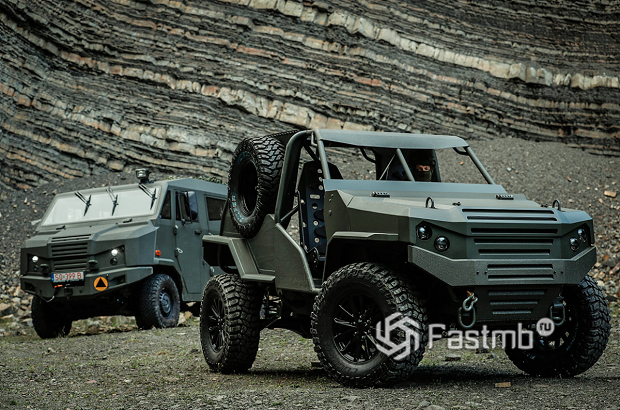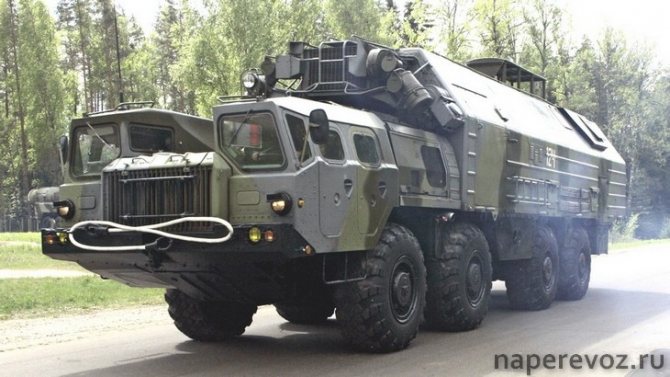
Maz 543 - Hurricane tractor
Content
- MAZ 543 - characteristics and modifications
- Historical information
- Cab features
- Technical specifications
- General characteristics
- MAZ-543A
- MAZ-543M
- Intermediate and single line machines
- Fireman "Hurricane"
- MAZ-543 today
- Characteristics of the combat vehicle MAZ-543 and several popular modifications
- History of creation
- MAZ-543 family
- Design features
- Hack and predictor Aviator
- MAZ 543 - characteristics and modifications
Let's talk about the Maz 543 - Hurricane tractor.
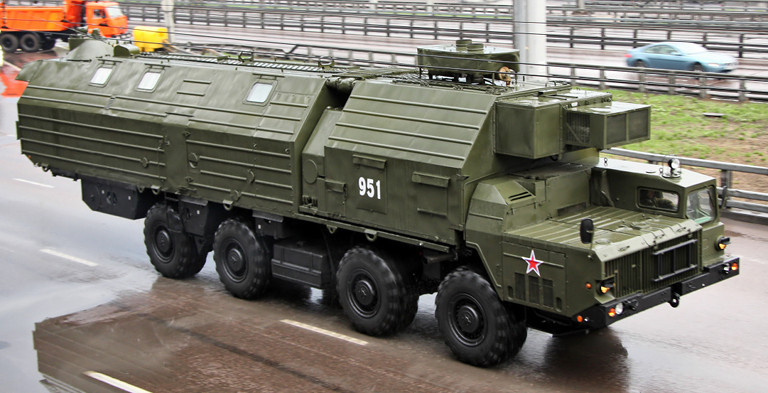
MAZ 543 - characteristics and modifications
For the first time MAZ-543 was designed at the Minsk Automobile Plant in the 60s, and so far its production has not been stopped. This is an all-wheel drive eight-wheeled truck, created as a military vehicle project and successfully implemented as part of the arms race between the USSR and the USA. A little later, trucks for industry and the national economy were created on this basis.
Historical information
The basis for the design of the "Hurricane" was the MAZ-537, from which the technicians borrowed the most successful frame, bridge and other elements. After upgrading the engine and control system, a unique MAZ-543 car was obtained, popularly nicknamed "Hurricane" due to its relatively high speed and good dynamics. Only 1959 years passed from the start of work in 3 to the release of the first prototypes, and in 1962 the first trucks began to be used to transport military equipment.
Cab features
Initially, MAZ-543 vehicles had a one-piece cabin and successfully passed tests for the transportation of missiles. However, the soon-to-be-developed missile system with a combat gun almost 12,5 m long could no longer fit on the existing chassis. There was only one way out: to lengthen the chassis, but this would be irrational and would require major structural changes.
The chief designer of the automobile plant of that time, Shaposhnikov, took a bold step and divided the entire cabin into two parts, between which was the "head" of the rocket. Such a unique solution turned out to be so successful that it was later used on other models of this type.
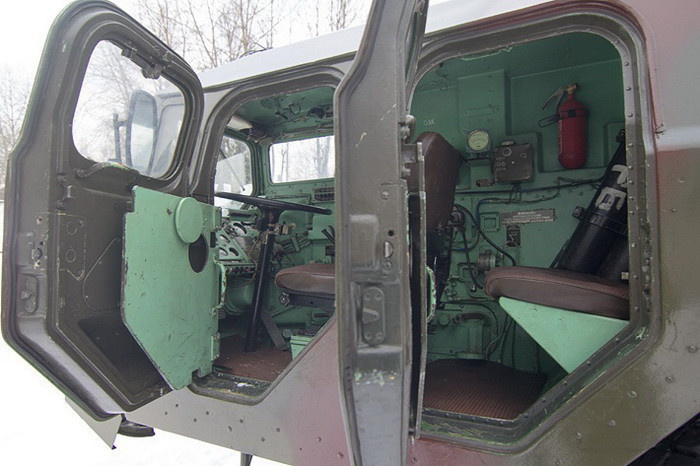
Technical specifications
The first copy of the MAZ-543 went into mass production in 1965, it had a carrying capacity of 19 tons, 4 people could be accommodated in two cabins, and the seats were arranged one behind the other. Since it was a unique model that had no analogues, many original and non-standard solutions were used in its design:
- Torsion-link suspension;
- 12-cylinder tank engine with 525 hp;
- 4-speed gearbox for smooth shifting;
- Wheelbase 8x8 with automatic pumping of each wheel;
- Standard solution: two fuel tanks of 250 liters, additional 180 liters;
- Maximum speed 60km/h;
- Consumption of 80-120 liters per 100 km.
General characteristics
The terms of reference for the design of the MAZ-543 contained many points that had to be taken into account when creating the machine. The characteristics described in the TOR directly affected the dimensions of the car:
- Width up to 3 m with a gauge of 2375 m, which allows you to fit into the road;
- Height up to 3 m provides high maneuverability of equipment even in urban areas if necessary;
- The length of just over 11,5 m allows you to place a rocket with a launcher, including an elongated version of the Temp-S thanks to separate cabins;
- Ground clearance 40cm;
- Loading height 1,85 m.
The main purpose of the MAZ-543 design - the placement of missile systems - was successfully achieved. After that, the car began to be used to transport various military equipment, and specific complexes were mounted on its base. The model was produced without changes until 1966, after which the first modification of the MAZ-543A appeared.
MAZ-543A
The first samples of the MAZ-543A modification appeared in 1963, but mass production was launched only in 1968. The model is very similar to the basic version with some minor differences:
- Carrying capacity increased from 19,1 to 19,4 tons;
- Increase in the working part of the frame;
- Slight displacement of the cabs forward.
This was enough to extend the launch until 2000. The main purpose of the vehicle was the mobility of the Temp-S launchers, which soon replaced the Tornadoes. In addition, communication complexes, truck cranes and power plants were assembled on the basis of the MAZ-543A.

MAZ-543M
MAZ-543M is rightfully considered the most successful option in the Hurricanes line. Its release began in 1976, while the basic design remained unchanged. Among the characteristics of the model:
- Load capacity 22,2 tons;
- The presence of a single cabin on the left side of the car;
- Expanded frame.
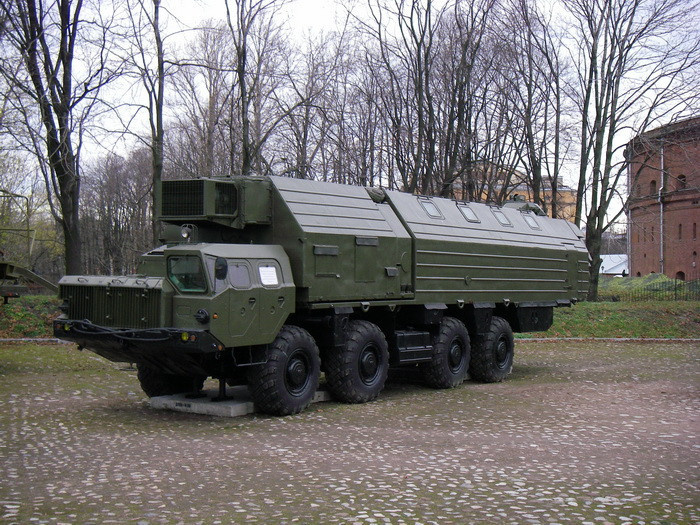
The main purpose of the modification was to transport elongated rocket and artillery systems. In remote areas of the country where there were no settlements, mobile dormitories with all the necessary systems for a comfortable stay, as well as mobile canteens, were installed on the chassis.
After 2000, the production of the MAZ-543 ceased, and even earlier, the production license was sold to the Wanshan manufacturer in China, which still sells trucks based on this technology. In Russia, the MAZ-543 was replaced by the improved MZKT-7390.
Intermediate and single line machines
Even before the appearance of the first modification, the designers applied various solutions to the basic technology, which led to the emergence of many small-scale variations.
- MAZ-543B - carrying capacity has been increased to 19,6 tons. The main purpose is the transportation of 9P117M launchers.
- MAZ-543V - the predecessor of the last successful modification had a cabin shifted forward, an elongated frame and an increased load capacity.
- MAZ-543P - a car of a simplified design was used for towing trailers, as well as for conducting exercises to train drivers of serious units. In a number of cases, the modification was exploited in the national economy.
- MAZ-543D is a single-seat model with a multi-fuel diesel engine. An interesting idea was not promoted because it was difficult to implement.
- MAZ-543T - the model is designed for comfortable movement in mountainous areas.
Fireman "Hurricane"
The modification of the MAZ-543 as a fire engine deserves special attention. The machine was created for use at airfields. The implementation turned out to be so successful that the teams still meet in the "Service".
Among the features of the MAZ fire engine, one can single out a water tank for 12 liters and an additional foam tank for 000 liters, which makes it possible to extinguish large-scale fires at airfields. Unfortunately, due to the bulky design, the car cannot be used in urban areas.
The only conspicuous drawback of the Hurricane fire modification is the high fuel consumption, reaching 100 liters.
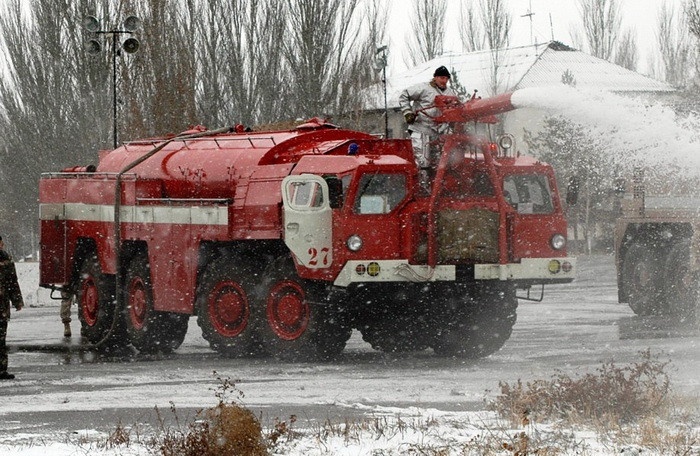
MAZ-543 today
Since the main use of the tractor was for military use, it is not surprising that it was not widely used in other areas. Over time, the vehicle ceased to be produced at all, although operating units of equipment are still found in remote landfills.
Since the Minsk Automobile Plant has been producing more advanced models for a long time, the need for the MAZ-543 has disappeared. However, custom-made production continues to work through official dealers, such as PK Russian Truck LLC.
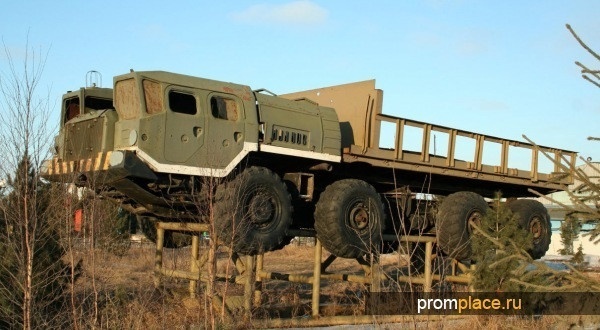
Characteristics of the combat vehicle MAZ-543 and several popular modifications
29.04.2019
MAZ-543 is a successful project of the USSR military-autoindustrial complex, which appeared in the 60s of the last century and is still being produced. In the 1960s, the Soviet Union recovered from the effects of World War II, after which it entered into an active arms race with the United States. Large funds and the best specialists of the Union went to the reconstruction of the Minsk Automobile Plant, which was supposed to become the industrial center of the USSR.
History of creation
Experienced engineers from Yaroslavl were sent to the Minsk plant. In 1959, the company received a new direction of development - the production of universal trucks. The creation and launch of the successful 537 series proved that special equipment can be produced in Minsk. In the late 50s, MAZ received the majority of government orders for the production of military equipment. The masters were given the task of creating a heavy-duty 4-axle all-wheel drive vehicle - a universal wheeled chassis on which military equipment could be installed. After various experiments, the designers decided to make a choice in favor of the wheelbase, abandoning the tracks.
The best was taken from the MAZ-537 model - the frame and the bridge. Many technical features have been significantly improved. For good speed and dynamics, the MAZ-543 car was named "Hurricane". By the middle of 1962, six prototypes were ready, which were sent to Volgograd to install military equipment on them.
MAZ-543 family
This transport was developed on the basis of the 537 version, having received improved units, a reliable wheelbase and a new cab. The diesel engine developed 525 horsepower. The box had three gears and was complemented by an automatic transmission. To improve patency, a remote tire pressure monitoring system was added.
the 543 family consisted of three main models: 543, 543A and 543M. A distinctive feature of the tractors was the location of the cab with a reverse slope of the windows - it was two-way (right and left). The length of the wheelbase was 7,7 meters, with a maximum load, the car reached speeds of up to 60 km / h. For every 100 km of track, 100 liters of diesel fuel were required.
MAZ-543
Chassis MAZ-543 is the first version of the series with a load capacity of 19,1 tons. After successful tests in 1962, mass production of the car began only in 1965. The cabins were isolated from each other, there was an engine compartment between them, each of them housed 2 people. Just over 1600 cars of this version were produced.
The People's Army of the GDR used this chassis as mobile repair and recovery modules. A body covered with an awning was mounted on the car, in which they could transport the necessary equipment and specialists, protecting them from the weather.
In the early years, only missile systems were planned to be installed on this transport. The first was the prototype "Temp" in 1960. Then a 9P117 launcher from the new 9K72 complex was installed on it. After that, they decided to install a wide variety of military equipment.
MAZ-543A
In 1963, the MAZ-543A chassis was introduced, the carrying capacity of which was increased to 19,4 tons. The first samples were sent to Volgograd to be equipped with the Temp-S missile system. In 1966, after the start of industrial production, army bodies and superstructures began to be assembled for Model A. In 1968, mass production of this modification of the tractor began.
Option A had few differences from the basic version. The main ones include the displacement of the cabs forward, due to which the working part of the frame was increased to 7 meters. The production of this machine was completed in the middle of the "zero" years, for all the time more than 2,6 thousand copies were produced.
The main purpose of the machine was the transportation of Temp rocket launchers. In addition, the necessary equipment for loading the complex was transported. Less commonly, the Smerch multiple launch rocket system was installed on the chassis. The machine was universal, any add-ons were used, the creation of mobile command posts, radar stations, field hotels for soldiers, etc.
MAZ-543M
The best MAZ-543M chassis, which became the basis for the entire series, was developed in 1974. It was distinguished from its two predecessors by the presence of a cab on the left and an increased carrying capacity (22,2 tons). The basic structure has not changed.
In addition to the installation of military equipment, the plant decided to combine the MAZ-543 with an all-metal platform, which made it possible to transport goods and soldiers. The modification did not receive distribution.
This model has long gone down in history. It was equipped with modern and powerful weapons, as well as numerous combat superstructures. The transport transported the Smerch combat installation, the Bereg coastal complex, the Rubezh missile system, various types of S-300 anti-aircraft guns, and much more.
4500 copies of the MAZ-543M chassis were produced in the world. During the collapse of the USSR, mass production had to be stopped, but the Minsk Automobile Plant continued to produce small batches by order of the government. By the mid-2000s, more than 11 specimens of the entire family had been collected.
In 1990, on the basis of version 543, the MAZ-7930 truck was developed, which differed from its counterpart in a 12-cylinder engine with a capacity of 500 hp and an all-metal body. Despite the collapse of the Union, in 1994 the prototypes of this version passed the necessary tests and were launched on a transport ship called MZKT-7390. This transport is used by the Russian army to install various weapons and modules.
Small-scale versions of the 543rd
Over the years, small-scale versions were produced based on the standard MAZ-543M chassis. They did not receive a wide release, but were produced by special order. MAZ-543B was used for the upgraded 9P117M launcher from the 9K72 complex.
The little-known model B served as the basis for version M. The structure of some nodes was changed. The cab at the transport was left on the left, and the carrying capacity was increased to 19,6 tons. The machine was used for the installation of long and heavy equipment. A total of just under 250 copies were produced.
To perform various rear and economic tasks, the P model was released. It was used to train soldiers, as well as to transport artillery pieces and heavy trailers. Individual versions: D with conventional multi-fuel diesel and T for mountainous terrain.
Design features
The cab of the tractor was developed for the installation of a rocket launcher. The use of the classic cabin design made the transport high, which did not allow passing under bridges on public roads. Two strong cabins were made of polyester resin, between which the engine compartment was located. Each cabin was designed for 2 passengers. Soundproofing during operation did not let in more than 85 dB of noise.
Hurricane MAZ-543 was equipped with a frame welded with riveting from two steel beams, which were bolted at the intersection. Due to the special design of the frame, it was called "channel". The disadvantage of this constructive solution is a small loss of transport in free space. The chassis is equipped with independent suspension. The first two axles are adjustable. The brake system was taken from the 537th series.
There were no special changes in the steering and braking mechanism compared to the MAZ-537. The wheels are equipped with light alloy wheels. The tire projector was designed for off-road driving. Ground clearance - 400 millimeters.
Hack and predictor Aviator
The MAZ-543 tractor is rarely seen in the public sector. Its main purpose is military affairs: transportation of various trailers, installation of weapons and various special modules. Some parts received such transport in the form of field housing. The armament also consists of vehicles equipped with radar stations that allow you to monitor the situation in the air. In the secondary market, the car is not for sale, not for rent. Production continues to this day, but in small batches and only by state order.
Checked on myself. APC vs MAZ
MAZ 543 - characteristics and modifications
Initially, the car was planned to be used only for the installation of missile systems, but later on the basis of the MAZ-543 new combat systems and an extensive range of auxiliary equipment were created, which made it the most massive and widespread vehicle of the Soviet Army.
The main advantages of this model are high power, design reliability, build quality and cross-country ability, adaptability to efficient operation in any road conditions and climatic zone, relatively low curb weight, achieved through the widespread use of alloy steels, aluminum and fiberglass truck.
Articles / Military equipment A car with a thousand faces: the military professions of MAZ tractors
Once upon a time, at military parades, MAZ-543 vehicles with new types of weapons literally every year presented foreign observers with another shocking "surprise". Until recently, these machines have firmly retained their high status and are still in service with the Russian army.
The design of a new generation of four-axle heavy-duty vehicles SKB-1 of the Minsk Automobile Plant under the leadership of chief designer Boris Lvovich Shaposhnik began in the early 1960s, and the organization of production of the 543 family became possible only with the transfer of production of MAZ-537 truck tractors to the Kurgan plant. To assemble new cars at MAZ, a secret workshop was formed, later transformed into the production of special wheeled tractors, and SKB-1 became the Office of the Chief Designer No. 2 (UGK-2).
MAZ-543 family
According to the general layout and the added base, the MAZ-543 family was a faster and more maneuverable transport modification of the MAZ-537G truck tractors, having received upgraded units, new cabs and a significantly increased frame length. A 525-horsepower D12A-525A V12 diesel engine, an automatic transmission with a modernized torque converter and a three-speed gearbox, new disc wheels on a torsion bar suspension with adjustable pressure on wide rims called a riveted-welded live frame were installed on the chassis with the original suspension.
The basis of the 543 family was the base chassis MAZ-543, MAZ-543A and MAZ-543M with new fiberglass side cabs with a reverse slope of the windshields, which became a kind of "calling card" of the entire model range. The cabins had right and left options, and two crew members were located according to the original tandem scheme, in individual chairs one after another. The free space between them was used to install the radiator and accommodate the front of the rocket. All cars had a single wheelbase of 7,7 meters, when fully loaded, they developed a speed on the highway of 60 km / h and consumed 80 liters of fuel per 100 km.
MAZ-543
The ancestor of the 543 family was a "light" base chassis with a carrying capacity of 19,1 tons with a simple MAZ-543 index. The first six prototypes were assembled in the spring of 1962 and sent to the Volgograd plant "Barrikada" to install the missile system. The production of MAZ-543 cars began in the fall of 1965. In them, in front of the engine compartment, there were two two-door cabins isolated from each other, which predetermined a relatively small front overhang (2,5 m) and a mounting frame length of just over six meters. MAZ-543 cars were assembled in the amount of 1631 copies.
In the People's Army of the GDR, all-metal short bodies with a canopy and reinforced coupling devices were mounted on the MAZ-543 chassis, turning them into mobile recovery vehicles or ballast tractors.
At the first stage, the main purpose of this version was to carry experimental operational-tactical missile systems. The first of these was the mock-up system of the 9K71 Temp complex, followed by the 9P117 self-propelled launcher (SPU) of the new 9K72 complex.
The first samples of the Rubezh coastal missile system, a radio relay communication station, combat control points, a 9T35 combat crane, diesel power plants, etc. were also mounted on this base.
MAZ-543A
In 1963, the first sample of the MAZ-543A chassis with a carrying capacity of 19,4 tons was immediately under the installation of the SPU of the Temp-S operational-tactical missile system (OTRK), and later served as the basis for military corps and superstructures. Its industrial production began in 1966, and two years later it went into mass production.
The main difference between the car and the MAZ-543 model was the rearrangement of the undercarriage, imperceptible from the outside, due to a slight forward displacement of both cabs. This meant a meager increase in the front overhang (only 93 mm) and an extension of the useful part of the frame to seven meters. Until the mid-2000s, more than 2600 MAZ-543A chassis were produced.
The main and most serious purpose of the MAZ-543A was the transportation of the 9P120 OTRK Temp-S launcher and its cargo transport vehicle (TZM), as well as the TZM of the Smerch multiple launch rocket system.
An expanded set of military equipment was based on this vehicle: transport and installation units, truck cranes, mobile command posts, communications and defense vehicles for missile systems, radar equipment, workshops, power plants, and more.
Experimental and small-scale vehicles of the MAZ-543 family
In the late 1960s and early 1970s, the 543 family included several small-scale and experimental modifications. The first in alphabetical order were two prototypes of the MAZ-543B chassis, built on the basis of the MAZ-543 and used to install the improved 9P117M launcher of the 9K72 complex.
The main novelty was the little-known prototype MAZ-543V with a fundamentally different design and a carrying capacity of 19,6 tons, which served as the basis for the later known version of the MAZ-543M. Unlike its predecessors, for the first time it had a forward-biased single double cab, located on the left side next to the engine compartment. This arrangement made it possible to significantly lengthen the mounting part of the frame for the installation of larger equipment. Chassis MAZ-543V was assembled in the amount of 233 copies.
To carry out rear transport operations in the Soviet army and the national economy in the mid-1960s, a multi-purpose airborne version of the MAZ-543P dual-purpose was developed, which served as training vehicles or ballast tractors for towing artillery pieces and heavy trailers.
Little-known individual prototypes that did not receive development included the MAZ-543D chassis with a multi-fuel version of the standard diesel engine and the experimental "tropical" MAZ-543T for operation in mountainous desert areas.
MAZ-543M
In 1976, two years after the creation and testing of the prototype, the most successful, advanced and economical chassis MAZ-543M was born, which immediately went into production and into service, and then headed the entire 543 family. The new car differed from the first two machines 543/543А due to the installation of only the left cab, located next to the engine compartment and shifted to the front overhang of the frame, which reached its maximum (2,8 m). At the same time, all units and components have not changed, and the carrying capacity has increased to 22,2 tons.
Some modifications of this vehicle included an experimental multi-purpose chassis with an all-metal side platform from a civilian dual-purpose truck MAZ-7310.
MAZ-543M was the most powerful and modern domestic weapons systems and numerous specialized superstructures and van bodies. It was equipped with the most powerful Smerch multiple launch rocket system in the world, launchers of the Bereg coastal artillery system and the Rubezh missile system, various types of S-300 anti-aircraft guns, etc.
The list of auxiliary means for providing mobile missile systems was the most extensive: mobile command posts, target designation, communications, combat service, defense and security vehicles, autonomous workshops and power plants, mobile canteens and sleeping quarters for crews, combat and many others.
The peak of the production of MAZ-543M cars fell on 1987. Until the mid-2000s, the Minsk Automobile Plant assembled more than 4,5 thousand cars of this series.
The collapse of the Soviet Union stopped the mass production of the three MAZ-543 base chassis, but they continued to be assembled in small batches with orders to replenish the fleet of decommissioned vehicles, as well as to test new promising weapons systems on them. In total, in the mid-2000s, more than 11 thousand vehicles of the 543 series were assembled in Minsk, which housed about a hundred weapons systems and military equipment. Since 1986, under license, the Chinese company Wanshan has been assembling modified vehicles of the MAZ-543 series under the brand name WS-2400.
In 1990, on the eve of the collapse of the USSR, a 22-ton multi-purpose prototype MAZ-7930 was created with a multi-fuel V12 engine with a capacity of 500 hp and a multi-stage transmission from the Yaroslavl Motor Plant, a new monoblock cabin and a high-sided steel body.
Meanwhile, on February 7, 1991, the military unit of the Minsk Automobile Plant withdrew from the main enterprise and was transformed into the Minsk Wheel Tractor Plant (MZKT) with its own production facilities and research center. Despite this, in 1994, prototypes were tested, four years later they went into production, and in February 2003, under the brand name MZKT-7930, they were accepted for supply to the Russian army, where they serve to mount new weapons and superstructures.
Until now, the base machines of the MAZ-543 family remain in the production program of the MZKT and, if necessary, can be put on the conveyor again.
